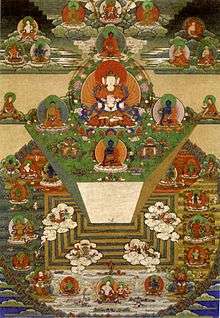Mount Meru (Buddhism)
Mount Meru (also Sumeru (Sanskrit) or Sineru (Pāli) or Kangrinboqe) is the name of the central world-mountain in Buddhist cosmology. Etymologically, the proper name of the mountain is Meru (Pāli Meru), to which is added the approbatory prefix su-, resulting in the meaning "excellent Meru" or "wonderful Meru".[1]

| Translations of Mount Meru | |
|---|---|
| English | wonderful Meru |
| Khmer | ភ្នំព្រះសុមេរុ (Phnom Preah So Mae) |
| Glossary of Buddhism | |
The concept of Sumeru is closely related to the central Mount Meru of Hindu cosmology, but it differs from the Hindu concept in several particulars.
Characteristics

According to Vasubandhu's Abhidharmakośabhāṣyam (philosophical writings), Sumeru is 80,000 yojanas tall. The exact measure of one yojana is uncertain, but some accounts put it at about 24,000 feet, or approximately 4-1/2 miles, but other accounts put it at about 7-9 miles. It also descends beneath the surface of the surrounding waters to a depth of 80,000 yojanas, being founded upon the basal layer of Earth. Sumeru is often used as a simile for both size and stability in Buddhist texts.
Sumeru is said to be shaped like an hourglass, with a top and base of 80,000 yojanas square, but narrowing in the middle (i.e., at a height of 40,000 yojanas) to 20,000 yojanas square.
Sumeru is the polar center of a mandala-like complex of seas and mountains. The square base of Sumeru is surrounded by a square moat-like ocean, which is in turn surrounded by a ring (or rather square) wall of mountains, which is in turn surrounded by a sea, each diminishing in width and height from the one closer to Sumeru. There are seven seas and seven surrounding mountain-walls, until one comes to the vast outer sea which forms most of the surface of the world, in which the known continents are merely small islands. The known world, which is on the continent of Jambudvipa, is directly south of Sumeru.
The dimensions stated in the Abhidharmakośabhāṣyam are shown in the table below:
| Name | Width | Height/Depth |
|---|---|---|
| Sumeru (Sineru) mountain | 80,000 yojanas | 80,000 yojanas |
| Sea | 80,000 yojanas | 80,000 yojanas |
| Yugandhara mountains | 40,000 yojanas | 40,000 yojanas |
| Sea | 40,000 yojanas | 40,000 yojanas |
| Iṣadhara (Isadhara) mountains | 20,000 yojanas | 20,000 yojanas |
| Sea | 20,000 yojanas | 20,000 yojanas |
| Khadiraka (Karavīka) mountains | 10,000 yojanas | 10,000 yojanas |
| Sea | 10,000 yojanas | 10,000 yojanas |
| Sudarśana (Sudassana) mountains | 5,000 yojanas | 5,000 yojanas |
| Sea | 5,000 yojanas | 5,000 yojanas |
| Aśvakarṇa (Assakaṇṇa) mountains | 2,500 yojanas | 2,500 yojanas |
| Sea | 2,500 yojanas | 2,500 yojanas |
| Vinadhara (Vinataka) mountains | 1,250 yojanas | 1,250 yojanas |
| Sea | 1,250 yojanas | 1,250 yojanas |
| Nimindhara (Nemindhara) mountains | 625 yojanas | 625 yojanas |
| Outer Sea | 32,000 yojanas | relatively shallow |
| Cakravāḍa (Cakkavāḷa) mountains
(circular edge of the world) |
312.5 yojanas | 312.5 yojanas |
The 80,000 yojana square top of Sumeru constitutes the Trāyastriṃśa "heaven" (devaloka), which is the highest plane in direct physical contact with the earth. The next 40,000 yojanas below this heaven consist of sheer precipice, narrowing in like an inverted mountain until it is 20,000 yojanas square at a heigh of 40,000 yojanas above the sea.
From this point Sumeru expands again, going down in four terraced ledges, each broader than the one above. The first terrace constitutes the "heaven" of the Four Great Kings and is divided into four parts, facing north, south, east and west. Each section is governed by one of the Four Great Kings, who faces outward toward the quarter of the world that he supervises.
40,000 yojanas is also the height at which the Sun and Moon circle Sumeru in a clockwise direction. This rotation explains the alteration of day and night; when the Sun is north of Sumeru, the shadow of the mountain is cast over the continent of Jambudvīpa, and it is night there; at the same time it is noon in the opposing northern continent of Uttarakuru, dawn in the eastern continent of Pūrvavideha, and dusk in the western continent of Aparagodānīya. Half a day later, when the Sun has moved to the south, it is noon in Jambudvīpa, dusk in Pūrvavideha, dawn in Aparagodānīya, and midnight in Uttarakuru.
The next three terraces down the slopes of Sumeru are each longer and broader by a factor of two. They contain the followers of the Four Great Kings, namely nāgas, yakṣas, gandharvas, and kumbhāṇḍas.
The names and dimensions of the terraces on the lower slopes of Sumeru are given below:
| Name | Height above the sea | Breadth | Length (on one side) |
|---|---|---|---|
| Cāturmahārājika | 40,000 yojanas | 2,000 yojanas | 24,000 yojanas |
| Sadāmada | 30,000 yojanas | 4,000 yojanas | 32,000 yojanas |
| Mālādhara | 20,000 yojanas | 8,000 yojanas | 48,000 yojanas |
| Karoṭapāni | 10,000 yojanas | 16,000 yojanas | 80,000 yojanas |
Below Sumeru, in the seas around it, is the abode of the Asuras who are at war with the Trāyastriṃśa gods.
References
- C., Huntington, John (2003). The circle of bliss : Buddhist meditational art. Bangdel, Dina., Thurman, Robert A. F., Los Angeles County Museum of Art., Columbus Museum of Art. Chicago: Serindia Publications. ISBN 1932476016. OCLC 52430713.
External links
- Painting of Sumeru found in Buddhist cave sanctuary in Xinjiang
- Mount Meru According to the Abhidharmakośa (Huntington Archive) Stūpa as Mount Meru (ibid.)